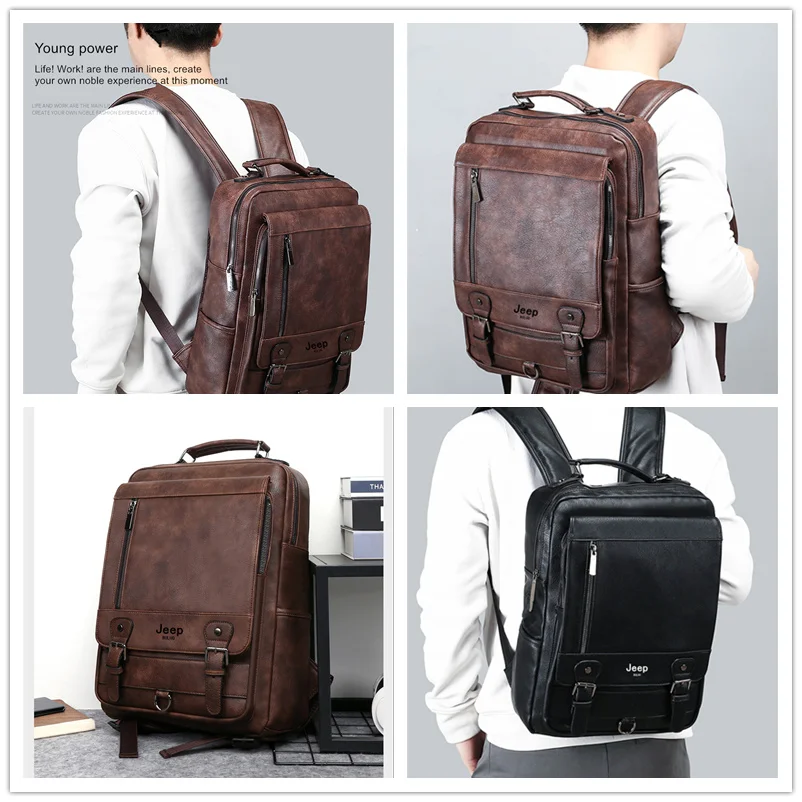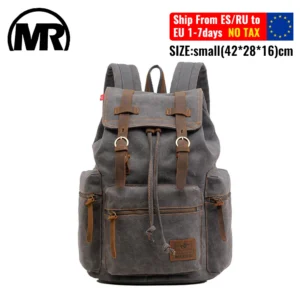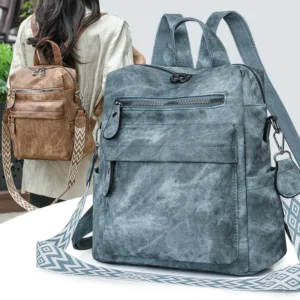Understanding Leather and Its Natural Properties
Leather is a remarkable natural material made from animal hides that have been tanned and treated to create a durable, flexible material. What makes leather special is its unique composition – it naturally contains oils that keep it soft, supple, and resistant to wear. These natural oils are essential to leather’s character and performance.
However, these natural oils don’t last forever. Over time, leather gradually loses its moisture and oils through:
- Regular use and handling that transfers oils away from the leather
- Environmental exposure to heat, sunlight, and dry air
- Natural aging processes that deplete the original conditioning
One of leather’s most important characteristics is its porosity. Unlike synthetic materials, genuine leather “breathes” – it absorbs and releases moisture, which helps maintain its flexibility and comfort. This breathing quality is part of what makes leather so comfortable and long-lasting.
The full-grain leather used in Summit Carry products exemplifies this natural beauty. When properly maintained, these oils enhance the leather’s character, developing a rich patina that tells the story of your adventures. The natural variations in grain and texture become more pronounced and beautiful over time, but only if the leather receives proper care.
Understanding these natural properties helps explain why leather conditioning and waterproofing matters – it’s not just about maintaining appearance, but about preserving the fundamental qualities that make leather special in the first place.
Do Leather Bags Need Oiling? The Short Answer
Yes, most genuine leather bags benefit from occasional conditioning or oiling. This isn’t just an optional step in leather care—it’s essential for maintaining the health and appearance of your leather bag.
Proper conditioning provides several key benefits:
- Replenishes natural oils that evaporate over time
- Maintains the leather’s flexibility, preventing it from becoming stiff and cracking
- Preserves the bag’s natural luster and rich appearance
- Creates a protective barrier against minor environmental damage
- Significantly extends your bag’s usable lifespan
Think of conditioning as an investment rather than a chore. A high-quality leather bag that receives proper care can last decades, developing character and becoming more beautiful with age. Without conditioning, that same bag might last only a few years before becoming dry, cracked, and ultimately unusable.
The ultimate guide to conditioning a leather backpack provides detailed information on preserving your leather goods for the long term. When you consider the cost difference between replacing a bag every few years versus maintaining one quality piece for decades, the value of proper conditioning becomes clear.
Not All Leather is Created Equal: Which Types Need Oiling
Different leather types have varying needs when it comes to conditioning. Understanding what kind of leather your bag is made from will help you determine the appropriate care regimen.
| Leather Type | Conditioning Needs | Recommended Frequency |
|---|---|---|
| Full-grain | Benefits greatly from regular conditioning | Every 3-6 months |
| Top-grain | Needs consistent conditioning | Every 4-8 months |
| Vegetable-tanned | Requires specific natural conditioners | Every 6-12 months |
| Chrome-tanned | Needs less frequent conditioning | Every 6-12 months |
Leathers That Should NOT Be Oiled:
Suede and Nubuck: These leathers have a napped surface that would be ruined by oil. Instead, use specialized suede/nubuck products that clean and protect without adding oils.
Patent Leather: This glossy, sealed leather has a protective coating that prevents oil absorption. Simple cleaning with a damp cloth is usually sufficient.
Faux/Vegan Leather: These synthetic materials don’t absorb oils like genuine leather. Using leather conditioners may damage the surface or create a sticky residue.
Exotic Leathers: Crocodile, snake, and other exotic leathers often require specialized care products specifically formulated for their unique properties.
Premium bags like those in our full-grain leather backpack collection feature the highest quality leather that develops a rich patina with proper conditioning. Full-grain leather shows the natural grain and imperfections that give each piece its unique character, making proper care even more important for preserving its distinctive qualities.
5 Clear Signs Your Leather Bag Needs Conditioning
Not sure if your leather bag needs attention? Here are five unmistakable indicators that it’s time for conditioning:
Dry, stiff texture – When leather loses its natural oils, it becomes noticeably stiff and rigid. Run your fingers across the surface – if it feels dry and inflexible rather than soft and supple, it’s time to condition.
Dull or faded appearance – Properly hydrated leather has a subtle natural sheen. When it starts looking matte, flat, or faded, that’s a clear sign the leather is thirsty and needs conditioning.
Fine lines or cracks – Examine your bag in good lighting. If you notice fine lines developing or small cracks beginning to form (especially in areas that bend frequently), these are early warning signs that the leather is too dry.
Reduced flexibility – Try gently bending a small portion of the bag. Healthy leather will flex smoothly and return to shape. If it resists bending or seems to strain, it needs conditioning.
Water absorption test – Place a tiny drop of water on an inconspicuous area of your bag. If it sits on the surface for 30-60 seconds before slowly absorbing, your leather is in good condition. If it immediately soaks in, the leather is dry and needs conditioning.
Before applying any conditioner, make sure you understand whether leather should dry before conditioning to achieve the best results and avoid potential damage.
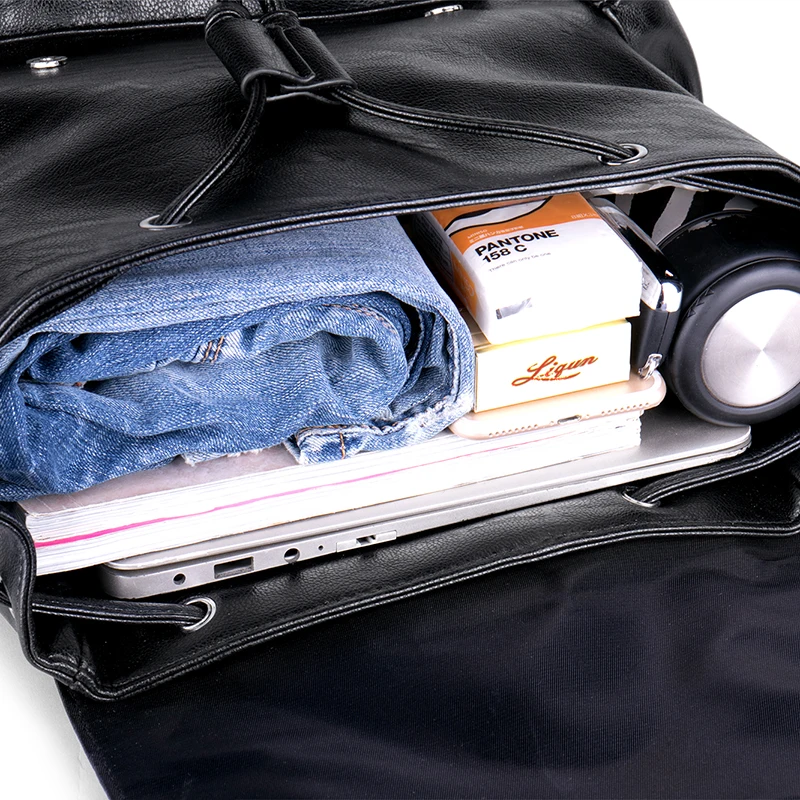
How Often Should You Oil Your Leather Bag?
Determining the ideal conditioning schedule for your leather bag depends on several factors. Here’s a general guideline to follow:
General Conditioning Frequency
- Frequently used bags (daily use): Every 3-6 months
- Occasionally used bags: At least once a year
- After cleaning: Always condition after cleaning your bag
- When showing signs of dryness: Condition whenever you notice the signs mentioned in the previous section
Factors That Affect Conditioning Frequency
Usage Intensity: The more frequently you use your bag, the more often it will need conditioning. A daily-use work bag will need more frequent care than one used only for special occasions.
Climate Conditions: Dry, arid environments cause leather to lose moisture faster. Similarly, extremely humid conditions can sometimes affect leather quality. Bags in desert climates may need conditioning every 2-3 months, while those in moderate climates might need it only twice a year.
Storage Environment: Bags stored in climate-controlled environments maintain their condition longer than those exposed to temperature fluctuations or extreme conditions.
Exposure to Elements: Frequent exposure to sunlight, rain, or temperature changes will increase the need for conditioning.
The most important approach is to “listen to your leather.” Learn to recognize when your specific bag shows signs of dryness, as leather items have individual needs based on their construction and use patterns.
Understanding whether oiling leather provides waterproofing can help you determine if you need additional products for water protection beyond basic conditioning.
Selecting the Right Leather Conditioner: What Works Best
Choosing the appropriate leather conditioner is crucial for maintaining your bag’s appearance and longevity. Different products offer varying benefits and results:
Types of Leather Conditioners
| Conditioner Type | Benefits | Potential Drawbacks | Best For |
|---|---|---|---|
| Cream Conditioners | Light application, minimal darkening, good absorption | Less deep conditioning | Light-colored leathers, regular maintenance |
| Oil-Based Conditioners | Deep penetration, excellent moisturizing | May darken leather significantly | Very dry leather, darker leathers |
| Wax-Based Products | Added water resistance, creates shine | Can build up with overuse | Bags frequently exposed to elements |
| Hybrid Products | Balanced properties | Varies by formulation | General-purpose conditioning |
Common Conditioning Substances
Mink Oil: Provides deep conditioning and water resistance but causes significant darkening. Best for boots and darker bags where color change is acceptable.
Neatsfoot Oil: Excellent for softening stiff leather but causes considerable darkening. Use cautiously on bags where color preservation matters.
Beeswax-Based Conditioners: Create a protective barrier with moderate shine and water resistance. Good for bags exposed to light rain or snow.
Commercial Leather Balms: Offer balanced properties with controlled application. Many are specially formulated for specific leather types.
Ingredients to Avoid
- Petroleum-Based Products: Can initially soften leather but may cause drying and cracking over time.
- Silicone: Creates a seal that prevents leather from breathing naturally.
- Household Oils (olive oil, vegetable oil): Can go rancid within the leather, causing odor and deterioration.
For premium leather bags, investing in quality conditioners specifically designed for fine leather is worth the cost. The right leather waterproofing products will maintain your bag’s beauty while providing appropriate protection.
Step-by-Step Guide: How to Properly Condition Your Leather Bag
Follow these steps to condition your leather bag safely and effectively:
1. Preparation Phase
- Empty your bag completely, removing all items from pockets and compartments
- Clean the bag using a soft cloth slightly dampened with water or a specialized leather cleaner
- Gently remove surface dirt and stains using circular motions
- Allow the bag to dry completely (usually 24 hours) before conditioning
- Place in a well-ventilated area away from direct heat sources
2. Test in an Inconspicuous Area
- Apply a small amount of conditioner to a hidden part of the bag (inside flap, bottom corner)
- Wait 24 hours to observe any color changes or adverse reactions
- Proceed only if the test area looks good
3. Application Process
- Apply a pea-sized amount of conditioner to a clean, soft cloth (never directly onto the leather)
- Work in small sections using gentle circular motions
- Use light pressure and ensure even application
- Pay special attention to dry areas, edges, and seams
- Remember: less is more—it’s better to apply multiple light coats than one heavy one
4. Absorption Period
- Allow 15-30 minutes for the leather to absorb the conditioner
- The surface should feel slightly damp but not wet or sticky
- If areas appear overly saturated, gently wipe away excess with a clean cloth
5. Buffing Process
- Use a separate clean, dry cloth to thoroughly buff the surface
- Apply moderate pressure in circular motions
- Continue until the leather has a natural, even sheen without oily residue
6. Final Drying
- Allow the bag to air dry for 12-24 hours in a well-ventilated area
- Keep away from direct heat sources and sunlight during this time
- Don’t use or handle the bag until it’s completely dry
Understanding how to clean a leather backpack properly before conditioning will help ensure the best results and prevent potential damage.

Common Mistakes and How to Avoid Them
Even with good intentions, leather care can go wrong. Here are common mistakes and solutions:
Over-conditioning
Problem: Applying too much product leads to a greasy, saturated surface that attracts dirt and may stain clothing.
Solution: Use minimal product on your application cloth—a little goes a long way. Multiple light applications are better than one heavy coat. If you’ve over-conditioned, gently wipe the surface with a dry cloth to remove excess product.
Using Inappropriate Products
Problem: Using the wrong conditioner can cause discoloration, damage the leather’s finish, or leave a sticky residue.
Solution: Always research product compatibility with your specific leather type. Invest in quality conditioners designed for fine leather goods rather than all-purpose products.
Uneven Application
Problem: Patchy, inconsistent appearance with some areas looking darker or shinier than others.
Solution: Work systematically in small sections, using consistent pressure and circular motions. Take your time and ensure even coverage before moving to the next section.
Skipping the Test Patch
Problem: Unexpected color darkening or adverse reactions across visible areas of your bag.
Solution: Always test any new product on an inconspicuous area and wait 24 hours to observe results before full application.
Conditioning Dirty Leather
Problem: Trapping dirt particles in the leather, which can cause abrasion and accelerated wear.
Solution: Always clean your bag thoroughly and allow it to dry completely before applying any conditioner.
Our leather backpacks are designed with premium materials that respond beautifully to proper care but can show signs of improper treatment. Taking the time to avoid these common mistakes will help preserve your investment.
14 Inch Leather Laptop Backpack, Brown Leather Backpack, Men's Leather Backpack, Vintage Leather Backpack
Price range: $177.28 through $199.12 Select options This product has multiple variants. The options may be chosen on the product pageCarry On Leather Backpack, Roll Top Leather Backpack
Price range: $77.76 through $96.48 Select options This product has multiple variants. The options may be chosen on the product pageDesigner Mini Backpack, Mini Leather Backpack, Small Leather Sling Backpack, Women's Leather Backpack
Price range: $95.76 through $98.80 Select options This product has multiple variants. The options may be chosen on the product pageDesigner Mini Backpack, Designer Women's Backpack, Mini Leather Backpack, Women's Leather Backpack
Price range: $135.92 through $137.64 Select options This product has multiple variants. The options may be chosen on the product pageBlack Leather Backpack, Small Leather Backpack, Women's Leather Backpack
Price range: $112.96 through $116.12 Select options This product has multiple variants. The options may be chosen on the product page- Price range: $80.72 through $108.04 Select options This product has multiple variants. The options may be chosen on the product page
Comprehensive Leather Bag Care: Beyond Conditioning
While conditioning is essential, complete leather care involves several other important practices:
Regular Cleaning Routine
- Dust with a soft, dry cloth weekly to prevent dirt buildup
- Address spills and stains immediately by blotting (never rubbing)
- Schedule deeper cleaning with appropriate leather cleaners every few months
- Always allow complete drying before conditioning or using the bag
Proper Storage Practices
- Store in a breathable cotton dust bag when not in use
- Stuff the bag with acid-free tissue paper to maintain its shape
- Never use plastic bags for storage as they trap moisture and can cause mildew
- Keep away from direct sunlight, which can fade and dry out leather
- Store in a cool, dry place with moderate humidity
Handling with Care
- Wash hands before handling to prevent oil and dirt transfer
- Avoid contact with potentially staining substances (oils, makeup, ink)
- Be mindful of rough surfaces that might scratch the leather
- Remember that dark denim and other dyed fabrics can transfer color to light-colored leather
Weather Protection
- Apply appropriate water repellent products before rainy seasons
- Take extra precautions during extreme weather conditions
- If your bag gets wet, dry it naturally at room temperature
- Never use heat sources (hair dryers, radiators) to speed drying
Our luxury leather backpack collection represents a significant investment that deserves comprehensive care. With proper maintenance, these premium pieces will continue to look beautiful and function perfectly for years to come.
Special Situations: When to Seek Professional Help
While regular maintenance can be handled at home, certain situations call for professional expertise:
When DIY Solutions Aren’t Enough
- Severe staining or discoloration that resists gentle cleaning
- Structural damage including torn seams or lining issues
- Mold or mildew development that persists after surface cleaning
- Hardware problems with zippers, clasps, or buckles
- Deep scratches or gouges in the leather surface
Benefits of Professional Leather Care Services
- Access to specialized cleaning methods not available to consumers
- Professional-grade restoration products that require expert application
- Experience with rare or exotic leathers that need specific treatments
- Ability to repair structural issues without compromising integrity
- Color restoration and matching services for damaged areas
Finding a Reputable Leather Care Professional
Look for specialists who work specifically with leather goods rather than general repair shops. Ask about their experience with premium leather items, and request before-and-after photos of previous restorations.
For vintage pieces in our vintage leather backpack collection, professional restoration can address age-related issues while preserving the unique character and patina that makes these items special.
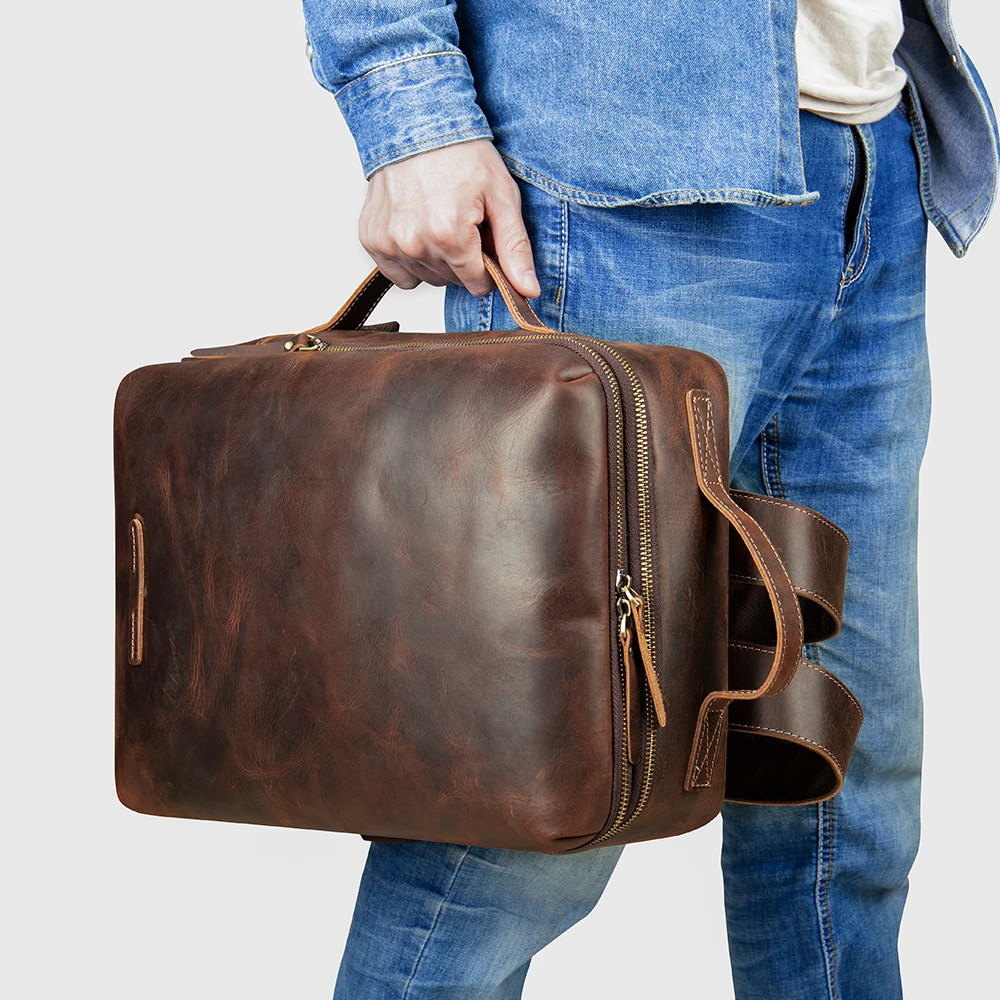
FAQ: Quick Answers to Common Leather Conditioning Questions
Can I use olive oil or coconut oil on my leather bag?
No, household oils like olive or coconut oil should never be used on leather bags. While they might provide temporary softening, these oils can go rancid within the leather, causing unpleasant odors and potential damage to the material structure. Always use conditioners specifically formulated for leather.
Will conditioning darken my light-colored leather bag?
Most leather conditioners will darken leather to some degree, particularly on lighter colors. The amount of darkening depends on the specific product and leather type. Always test on an inconspicuous area first and consider using conditioners specifically designed for light-colored leathers, which minimize color changes.
How can I tell if my bag is genuine leather versus synthetic?
Genuine leather has a distinctive smell and irregular grain pattern. It will also absorb small amounts of moisture rather than having water bead on the surface. When touched with a warm hand, genuine leather warms up and feels soft, while synthetic materials remain cool and uniform in texture.
Can I condition a vintage or antique leather bag?
Yes, but with caution. Vintage leather often benefits from conditioning but may require gentler products. Start with a very light application of a natural conditioner, and be aware that older leather may absorb product differently than newer materials. For valuable antiques, consulting a professional is recommended.
Is there a difference between leather conditioner and leather oil?
Yes. Leather conditioners are typically cream or lotion-based products designed to moisturize without oversaturating. They often contain waxes and other ingredients that nourish and protect. Leather oils are more concentrated, penetrate deeper, and typically cause more darkening. Conditioners are generally better for regular maintenance, while oils might be used for very dry or neglected leather.
Comprehensive information on how to maintain a leather backpack can help you develop a complete care routine tailored to your specific leather goods.
The Value of Proper Leather Care: Protecting Your Investment
Taking the time to properly care for your leather bag is more than just maintenance—it’s preserving an investment. Quality leather goods are unique among fashion accessories in that they can actually improve with age when properly maintained.
Regular conditioning and proper care provide tangible benefits:
- Extended usable lifespan measured in decades rather than seasons
- Development of a rich, unique patina that can’t be manufactured
- Maintained functionality of straps, handles, and closures
- Better value over time compared to repeatedly replacing lower-quality items
Unlike synthetic materials that deteriorate with age, well-maintained leather develops character and becomes more personal to its owner. The subtle marks, softening, and color development tell the story of your adventures together.
The men’s leather backpack collection exemplifies this quality-focused approach. Each piece is crafted with longevity in mind, using materials and construction methods designed to stand the test of time—but only with proper care.
While it may seem simple, regular conditioning is the foundation of leather care. This straightforward practice makes the difference between a bag that falls apart after a few years and one that becomes a trusted companion for life’s journeys.

